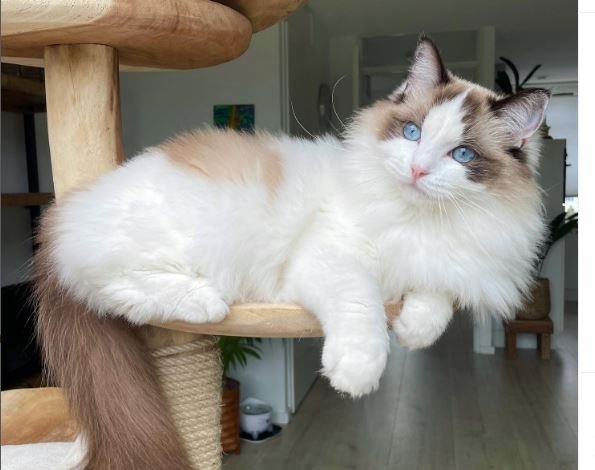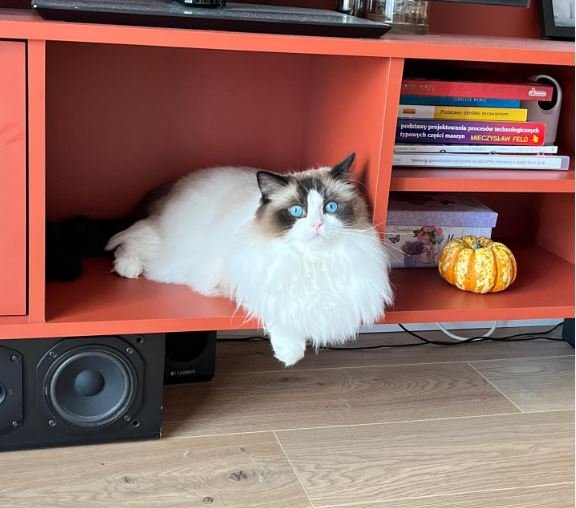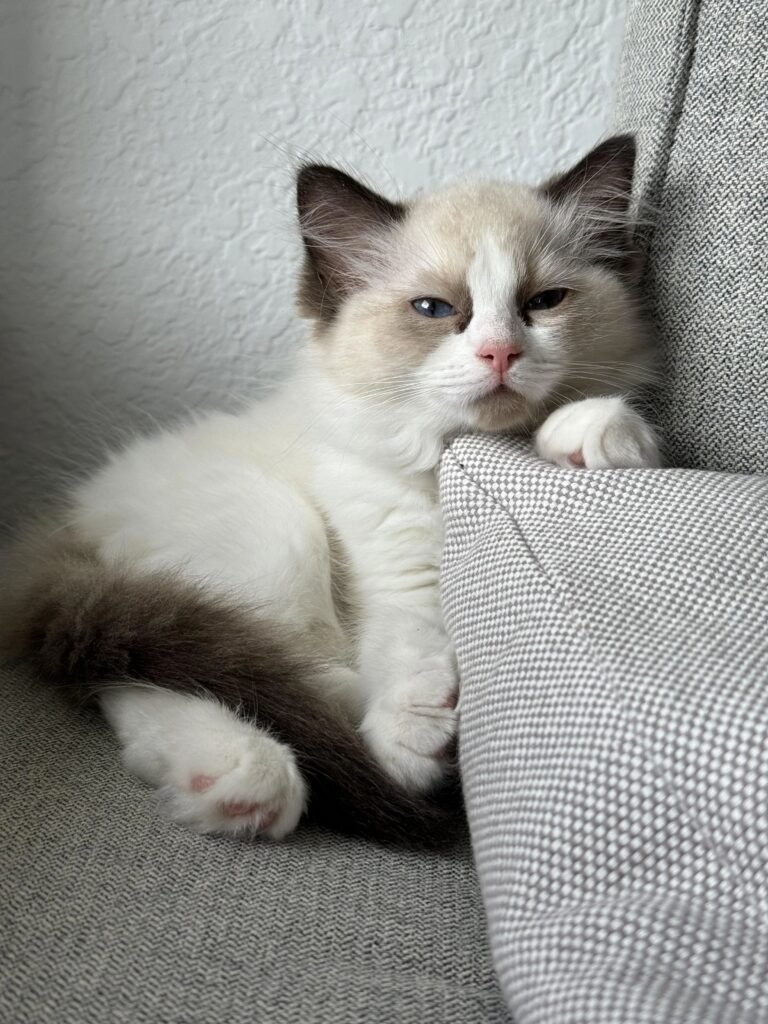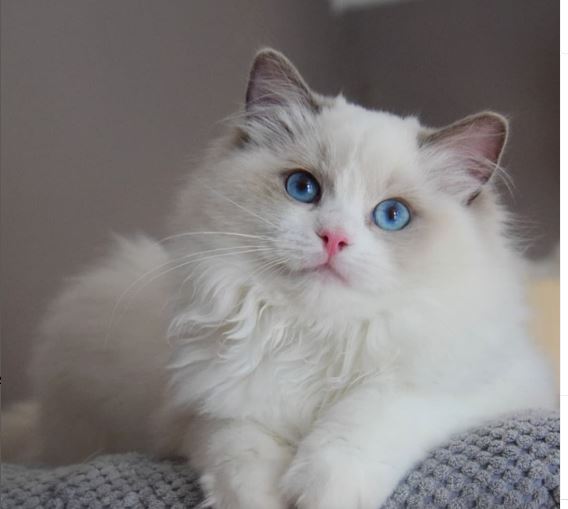The Ragdoll cat is undeniably one of the most captivating feline breeds, known for its affectionate nature, striking blue eyes, and luxurious coat. What makes these cats even more fascinating is the gradual transformation of their coat color, a process that unfolds over their early years. As a cat lover, especially if you’re a proud Ragdoll owner or breeder, understanding Ragdoll color progression is not just a fun curiosity—it’s essential knowledge that can help you better appreciate the beauty of your feline companion.
In this article, we will explore Ragdoll color progression in depth—unveiling the fascinating journey of how a Ragdoll kitten’s color changes over time, what factors influence this progression, and how to care for their coats during this transformation. This guide is perfect for new owners, experienced breeders, or anyone interested in learning more about the Ragdoll breed’s stunning evolution.
All Ragdolls Are Born White
One of the most fascinating aspects of Ragdoll cats is that all Ragdoll kittens are born completely white. This is a unique characteristic that sets Ragdolls apart from many other breeds, where kittens may show some color at birth. But why is this the case? The answer lies in the temperature-sensitive gene that dictates their color progression.
Why Are Ragdoll Kittens Born White?
Ragdoll kittens are born without any visible color because their temperature-sensitive gene, known as the CS gene (Siamese color-point gene), hasn’t yet been activated. At birth, the kittens’ bodies are warm, and this prevents the color-pigment from developing in the cooler areas (such as their ears, paws, face, and tail) that will eventually form the distinctive points. Essentially, their entire body is warm, so no color appears.
As the kittens grow and their body temperature begins to stabilize, the color points (on the cooler areas of the body) start to darken, and this is when the gradual transformation from a white kitten to a beautiful adult cat begins. This gradual progression of color over weeks and months is a hallmark of Ragdoll kittens.

What Are Ragdoll Colors and Patterns?
Before diving into the progression of colors, it’s important to understand the genetics and the unique color patterns that make Ragdolls stand out.
Ragdolls are colorpoint cats, which means their coat colors are darker on the cooler parts of their bodies (such as the face, ears, paws, and tail), and lighter on the warmer areas (like the torso). The color patterns include:
- Colorpoint: A pattern where the extremities (ears, face, paws, and tail) are darker than the rest of the body.
- Mitted: These cats have white paws (resembling mittens) and a white chin, while the body remains the color of their points.
- Bicolor: Ragdolls with this pattern features a white chest and belly, with color on the legs, tail, and face.
As for the colors themselves, the main shades are:
Lilac: A pale, greyish-blue with a slight pinkish tint.
Seal: A deep, rich brown.
Blue: A soft, silvery-grey.
Chocolate: A warm, milk-chocolate color.
Cream: Lighter points in a soft yellowish hue, sometimes seen in flame (red) and tortie varieties.
Your Ultimate Guide to Ragdoll Cat Colors & Patterns
Other websites that will show you color and patterns are here.
- Ragdoll Fanciers Club International Color Chart
- Le Ragdoll Club France
- Ragdoll Fanciers Club Color Chart
- Ragdoll Fanciers Worldwide Color Chart

Ragdoll Color Progression Timeline
Week 1-2: The Newborn Phase
At birth, Ragdoll kittens have pale or light-colored coats. Their eyes are typically closed, and they are completely dependent on their mother. During this phase, there is no visible color change, as the pigmentation hasn’t fully developed. It’s important to note that this is the stage when colorpoint patterns first begin to emerge.
Week 4: Early Signs of Color Change
Around 4 weeks of age, the Ragdoll kitten’s body temperature stabilizes, and the first signs of pigmentation appear, particularly on the ears, face, and tail. These areas are colder than the kitten’s body and will begin to reveal darker shades of color. At this point, you may see hints of what the kitten’s final color will be.
Week 8: Color Intensifies
By the time your Ragdoll kitten reaches 8 weeks, the color changes become more apparent. The points on the ears, face, paws, and tail are much darker, and the body will remain light. However, the kitten may still look quite different from its adult coloration. At this stage, it’s easier to predict the eventual color, but the full development isn’t complete.
Months 4-6: The Mid-Stage Transition
Between 4 to 6 months, the kitten’s coat color is starting to become more defined. However, their body may still be lighter than the final adult shade. The color on the extremities becomes more pronounced, while the body fur retains its pale, cream-like hue. This period is a key time when many Ragdoll owners first noticed the full impact of the coat’s transformation.
Years 1-2: Approaching Adulthood
Ragdolls are slow-maturing cats. The major color changes continue well into their first year, and some cats may not reach their final adult coloration until 2-3 years of age. During this time, the coat continues to darken in places like the ears and tail, while the body may slowly deepen into the final shade.
Year 3 and Beyond: Full Adult Color
By the time your Ragdoll reaches 2-3 years, it will have reached its full adult color. The coat is now the rich, deep shade that’s characteristic of its breed. At this stage, your Ragdoll’s coat should be its most vibrant and striking, with the unique colorpoint, mitted, or bicolor patterns fully visible.y genetics can help breeders predict and appreciate the intricate beauty that tabby patterns bring to these beloved feline companions.

Is the Growth Process the Same for All Colors and Patterns?
While the growth process for colors and patterns in Ragdolls follows a general pattern (with kittens born white and slowly developing their distinctive features), there are slight variations in how quickly the colors and patterns show up:
- The speed of color development: Some colors, like Seal, are more pronounced early on, while lighter colors, like Lilac or Cinnamon, take longer to fully develop. This is because the pigments in these colors need more time to show through as the kitten grows.
- The appearance of patterns: Similarly, patterns like Mitted and Bicolor often show up early and become clearer around 8-12 weeks, but other patterns, like Lynx or Torbie, can take longer to become fully visible, typically around 12 weeks.
Important Fact: By the time a Ragdoll reaches 1 year of age, their full adult coloring and pattern will be visible. However, in the first few months, there may be subtle differences in how pronounced or developed the colors and patterns appear.
Frequently Asked Questions
Do Ragdolls’ Coat Colors Change With Age?
Yes, coat colors can change with age due to developmental changes in coat color genetics. Color patterns may shift as a cat ages, influenced by aging effects on the coat. It’s a natural process.
Are There Any Rare Color Variations in Ragdolls?
Like finding a needle in a haystack, rare color variations in Ragdolls are elusive treasures. Genetic mutations can create unique hues. Breeding strategies play an important role in preserving and enhancing these exceptional traits.
Can Ragdolls Have Different Colored Eyes?
Yes, ragdolls can have different colored eyes due to genetic predisposition. This condition, known as heterochromia, is not uncommon among cats. While it’s usually harmless, some cases may indicate potential health implications that require monitoring.
What Factors Can Affect a Ragdoll’s Coat Color?
Genetic influences play a major role in a ragdoll’s coat color, while environmental factors can also have some impact. It’s fascinating how these elements come together to create the beautiful hues of our beloved feline friends.
Are There Specific Grooming Requirements for Different Ragdoll Colors?
We focus on coat maintenance for different ragdoll colors. Color genetics influence intensity. Specific grooming techniques enhance the beauty of each shade. Regular brushing and care tailored to their unique hues guarantee their coats stay vibrant.
Conclusion
The color progression of a Ragdoll kitten is one of the most fascinating aspects of the breed. From their soft, pale fur at birth to the rich, stunning shades they exhibit as adults, watching this transformation is an exciting journey for cat owners and breeders alike. By understanding the stages of Ragdoll color progression, you can better appreciate the beauty of your feline companion as they mature and ensure they receive the proper care during this important developmental phase.
If you’re a Ragdoll owner, you’re part of a special community that gets to witness this incredible transformation. Share your experiences, ask questions, or simply enjoy the beauty of your Ragdoll as they grow into the majestic cat they were always meant to be.

Hey guys, My name is Simon Smith. I’m from Canada and live near Victoria
I live with my sweet family and have 20+ Ragdolls of different types. I love them as my children. My profession is as a hotel manager.
I love to keep Ragdolls and grow their breeder case. I have 7 years of experience.
I’m an expert in cat care. So, I’m here to provide you with new information about my cats daily. This is my blog website, so I request that you kindly visit our site daily.
If you’re a Ragdolls lover and you have any questions or confusion about cats, text me on the Contact Us page or Gmail.
Thank u
